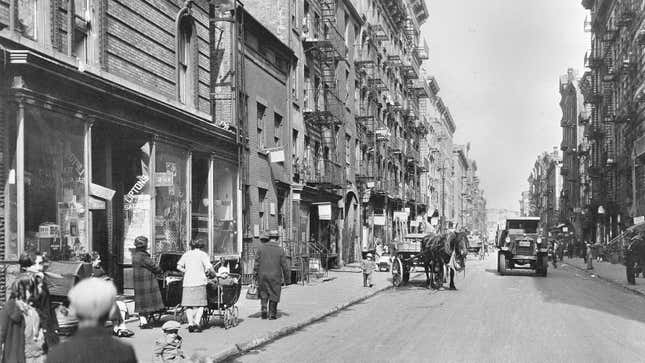The Lower East Side Housewives Who Wrote the Militant Playbook
In Depth
Image: AP Photos
In 1904, tenement residents living on New York City’s Lower East Side stopped paying rent. The tenants, mostly Jewish garment and trade workers crammed into small apartments, could barely afford the rent as it stood. So hundreds of residents, organized primarily by women activists, fought against it, organizing the first massive rent strike in opposition to landlords demanding increases. “We are all pledged not to pay you the increase in rent,” tenants told their landlords. “If you wish to turn us out you can do so, but notice will be sent all over the East Side and no new tenants will move in.” The strike was largely successful: newspapers reported that rents were lowered to pre-strike levels and eviction threats ceased, Jenna Weissman Joselit wrote in The Tenant Movement in New York City, 1904-1984. Rent strikes became a powerful bargaining chip in New York City’s tenant movement, a tactic enacted again and again in the decades that followed.
But before the city’s tenement population organized a strike over rising rent, they organized a strike over beef, one led by a group of Jewish housewives who were acutely aware of their collective bargaining power, one they would wield to great success.
Rent strikes became a powerful bargaining chip in New York City’s tenant movement, a tactic enacted again and again in the decades that followed
In May 1902 a group of Jewish housewives decided to organize a boycott against local butchers who were raising Kosher beef prices, the result of a “beef trust” run by just a few companies that had control of the market. The price of beef had risen from 12 cents a pound to 18 cents, historian Paula Hyman writes in “Immigrant Women and Consumer Protest: The New York City Kosher Meat Boycott of 1902,” and retail butchers tried to stop buying from wholesalers until they lowered their prices, a tactic that failed to knock down prices. A group of housewives including Sarah Edelson, Fanny Levy, and Paulina Finkel quickly moved to organize women to talk about the possibility of their own boycott. “The time has arrived when we must take a hand in this meat fight,” Finkel wrote in a Yiddish flyer distributed to women, Scott Seligman writes in his book The Great Kosher Meat War Of 1902, Immigrant Housewives and the Riots That Shook New York City. “With our money, the butchers buy diamonds and wear diamonds.”
“The next day, after a neighborhood canvas staged by the organizing committee, thousands of women streamed through the streets of the Lower East Side, breaking into butcher shops, flinging meat into the streets, and declaring a boycott,” Hyman writes. Newspapers reported that policemen were slapped in the face with “unpleasant moist liver,” as thousands crowded in protest, and police brutally beat protestors. “The women’s chants nearby were really interesting: ‘Working men labor very hard to afford meat,’ one yelled,” The Jewish Daily Forward reported at the time. “‘Women eat only their own flesh. Where is it supposed to come from? 17 cents a pound of meat, 6 cents a pound of bones!’”
The salacious media coverage of the strike at the time cast Jewish women as riotous mob
Women activists, eventually partially consolidated into the Ladies Anti-Beef Trust Association, went door to door, synagogue to synagogue, urging residents to cease buying beef until the prices were lowered. The movement expanded far beyond the housewives at its center, eventually attracting the Retail Butchers Association to the cause. By June, the strike had forced the price of Kosher beef down to 14 cents a pound. But the legacy of the beef strike would extend far beyond their immediate cause, influencing strikes in the tenement community for years to come, especially concerning rent. Later organizers of the 1904 rent strike would welcome comparisons between the beef and rent strikes. “Linking the two events together served to legitimate them and made one seem a natural consequence of the other,” Joselit writes. “And both, as the Forward liked to remind its readers had common origins as ‘great folk struggles.’”
The salacious media coverage of the strike at the time cast Jewish women as riotous mob, but that framing underestimated the strategic rigorousness of their organizing. “Lower East Side women were familiar with the political rhetoric of their day, with the workings of the market economy, and with the potential of consumers to affect the mark,” Hyman writes. Today, the example they set over a century ago remains relevant as the pandemic has invigorated a wave of tenants to explore withholding rent and consumers confront digital picket lines at corporations like Instacart and Walmart. Housewives like Sarah Edelson, Fanny Levy, and Paulina Finkel, often with four to six kids to a household, not only helped create a blueprint for tenement strikes to come, but chipped away at misconceptions about who does the groundwork in radical organizing, organizing that continues to this day.